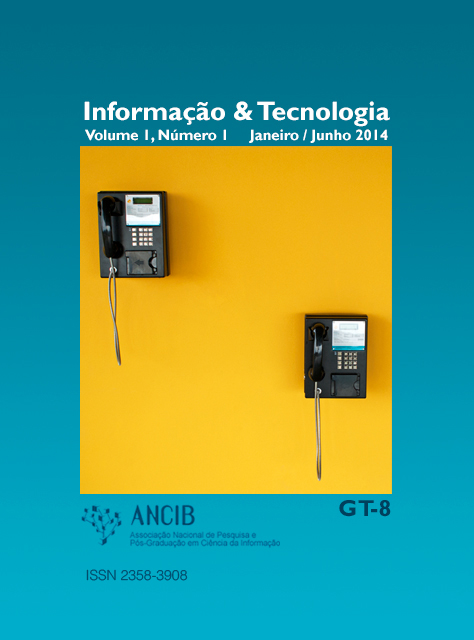Pervasive Information Architecture: uncovering the Resmini and Rosati heuristics
Abstract
Access and use of information are driven outside the Internet boundaries, going beyond the use of isolated or network computers. Mobile devices and real-time information systems are making interactions with the information practically constant, ubiquitous and holistic. This study presents a reflection from a bibliographical and exploratory research, in this scenario where it is necessary to reflect upon the unfolding of information architecture in contemporary times, featuring the points in which the interaction occur with hybrid information spaces and are considered a cross-channel design when related to user interaction, these evolve to the heuristics for a Pervasive Information Architecture proposed by Resmini and Rosati. These heuristics are essential to the design of this whole ecosystems that include physical and digital features, it is not possible to clearly predict user behavior, given the innumerous forms of interaction, especially when the need to share information on its interface become an important issue, focusing on having a fluid narrative using various types of artifacts. After the reflections undertaken it is expected to wake for this new way of understanding Information Architecture.
Downloads
References
ANDERSON, R. I. Coming Together to Explore the Intersections of HCI, Experience Design, and Information Architecture. Interactions, v. 9, n. 2, 2006.
BORKO, H. Information Science: what is it? American Documentation, Washington, v. 19, n. 1, p. 3-5, 1968.
COTTONG, S. What is service design? In: New management paradigms. 2010. Disponível em: <http://www.sylvaincottong.com/management-models/what-ist-service-design/> Acesso em: 27 maio 2014.
DOURISH, P. Following Where the Footprints Lead: Tracking Down New Roles for Social Navigation. In: Munro, Hook, and Benyon (eds.), Social Navigation of Information Space, London: Springer. 1999, p. 15-34.
DOURISH, P.; CHALMERS, M. Running Out of Space: Models of Information Navigation. Short paper presented at HCI ‘94, Glasgow. 1994. Disponível em: <http://www.dcs.gla.ac.uk/~matthew/papers/hci94.pdf> Acesso em: 20 maio 2014.
ELGAN, M. Dispatch from the post-pc revolution. Information Age, may/jun., p. 46-53. Australian Computer Society. Sydney: 2012. Disponível em: <http://issuu.com/idgau/docs/informationagejune2012>. Acesso em: 16 maio 2014.
GAVER, W. W. Technology Affordances. CHI '91 Proceedings of the SIGCHI Conference on Human Factors in Computing Systems. New York, 1991. p. 79-84.
GIL, A. C. Como elaborar projetos de pesquisa. São Paulo: Atlas, 1991.
GOMES, J. F. Ergonomia do Objeto – Sistema técnico de leitura ergonômica. São Paulo: Escrituras, 2004.
HICKS, E.; HICKS J. The Law of Attraction: The Basics of the Teachings of Abraham. By (Spirit), Published by Hay House, 2006.
IIDA, I. Ergonomia: projeto e produção. 2.ed. São Paulo: Edgard Blucher, 2005.
KUNIAVSKY, M. Smart Things. San Francisco, CA: Morgan Kaufmann, 2010.
LYNCH, K. The image of the city. Cambridge, Mass.: MIT Press, 1960.
MORVILLE, P. Ambient Findability. O’Reilly Media: 2005.
MCMULLIN, J.; STARMER, S. Leaving Flatland: Designing Services and Systems across Channels. Proceedings of 11th Information Architecture Summit. Phoenix, April 9-11. 2010. Disponível em: <http://www.slideshare.net/jessmcmullin/leaving-flatland-crosschannel-customer-experience-design>. Acesso em: 20 maio 2014.
MURRAY, Janet H. Inventing the medium: principles of interaction design as a cultural practice. Cambridge, MA: MIT Press. 2012.
POTENTE, D.; SALVINI, E. (2009). Apple, IKEA and Their Integrated Architecture. Bulletin of the American Society for Information Science and Technology, 35(4), 32–42, april/may. Disponível em: <http://www.asis.org/Bulletin/Apr-09/AprMay09_Potente-Salvini.pdf>. Acesso em: 26 maio 2014.
RESMINI, A.; ROSATI, L. Pervasive Information Architecture. Designing Cross-Chanel User Experiences. Burlington: Elsevier, 2011.
ROSCH, E.; LOYD, B. B. Cognition and Categorization. Erlbaum. 1978.
SIQUEIRA, J. Ferramentas de Criatividade SCAMPER. Siqueira Consultoria. Rio de Janeiro, 2007. Disponível em: <http://criatividade.files.wordpress.com/2007/02/scamper.pdf> Acesso em: 18 maio 2014.
SCHWARTZ, B. The Paradox of Choice: Why More Is Less. Harper Perennial, 2005.
TUAN, Yi-Fu. Espaço e lugar: a perspectiva da experiência. São Paulo: Difel, 1983.
VERGARA, S. C. Projetos e relatórios de pesquisa em administração. São Paulo: Atlas, 2006.
WEINBERGER, D. Everything Is Miscellaneous: The Power of the New Digital Disorder. Times Books, 2007.
WEISER, M. The Computer for the 21st Century. Scientific American Ubicomp Paper after Sci Am editing, 1991. Disponível em: <http://www.ubiq.com/hypertext/weiser/SciAmDraft3.html> Acesso em: 26 maio 2014.
WURMAN, R. S. Ansiedade de Informação 2. São Paulo: Editora de Cultura, 2001.



